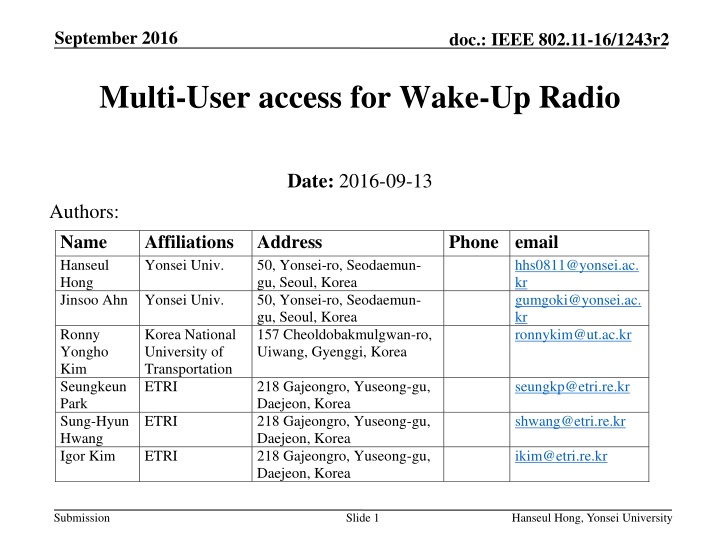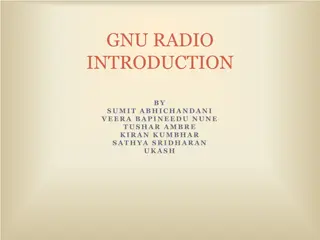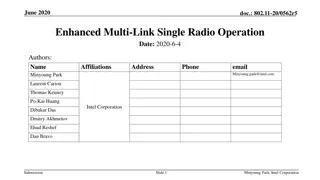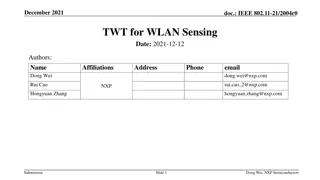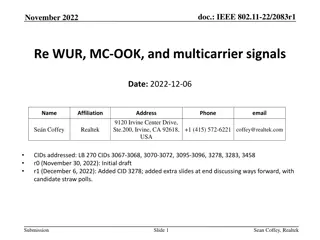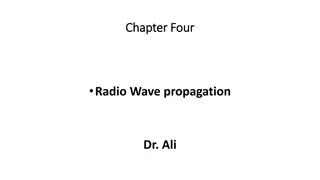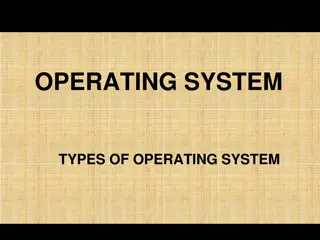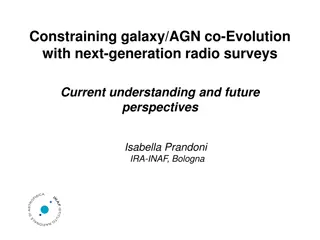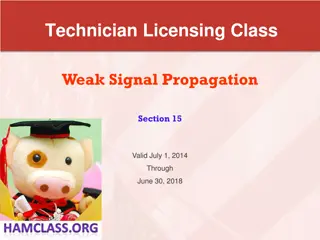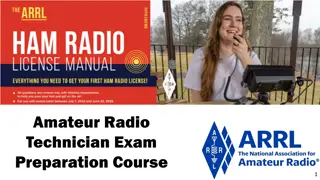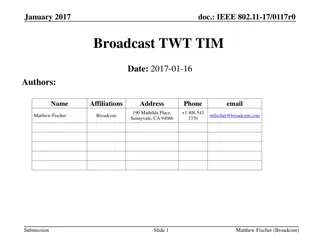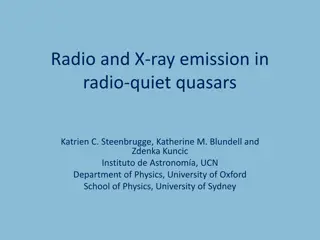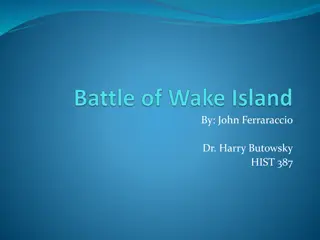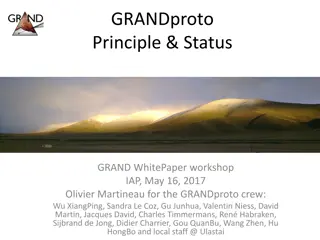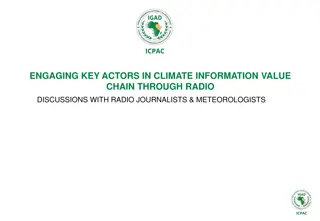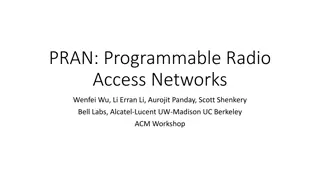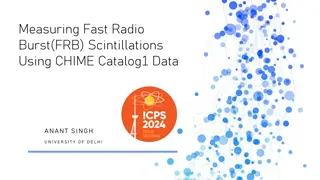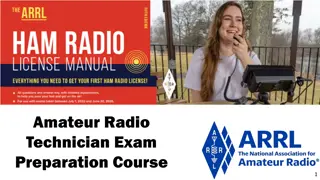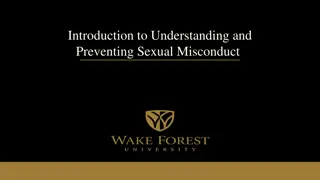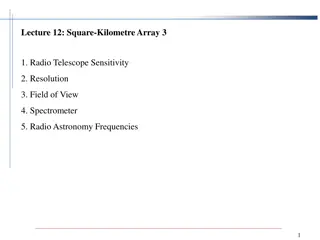Multi-User access for Wake-Up Radio
This document dated September 13, 2016, discusses multi-user access for wake-up radio technology in the context of IEEE 802.11 standards. The authors, Hanseul Hong and Jinsoo Ahn from Yonsei University, delve into the implications and advancements in this field.
Download Presentation

Please find below an Image/Link to download the presentation.
The content on the website is provided AS IS for your information and personal use only. It may not be sold, licensed, or shared on other websites without obtaining consent from the author.If you encounter any issues during the download, it is possible that the publisher has removed the file from their server.
You are allowed to download the files provided on this website for personal or commercial use, subject to the condition that they are used lawfully. All files are the property of their respective owners.
The content on the website is provided AS IS for your information and personal use only. It may not be sold, licensed, or shared on other websites without obtaining consent from the author.
E N D
Presentation Transcript
September 2016 doc.: IEEE 802.11-16/1243r2 Multi-User access for Wake-Up Radio Date: 2016-09-13 Authors: Name Hanseul Hong Jinsoo Ahn Yonsei Univ. Affiliations Yonsei Univ. Address 50, Yonsei-ro, Seodaemun- gu, Seoul, Korea 50, Yonsei-ro, Seodaemun- gu, Seoul, Korea 157 Cheoldobakmulgwan-ro, Uiwang, Gyenggi, Korea Phone email hhs0811@yonsei.ac. kr gumgoki@yonsei.ac. kr ronnykim@ut.ac.kr Ronny Yongho Kim Seungkeun Park Sung-Hyun Hwang Igor Kim Korea National University of Transportation ETRI 218 Gajeongro, Yuseong-gu, Daejeon, Korea 218 Gajeongro, Yuseong-gu, Daejeon, Korea 218 Gajeongro, Yuseong-gu, Daejeon, Korea seungkp@etri.re.kr ETRI shwang@etri.re.kr ETRI ikim@etri.re.kr Submission Slide 1 Hanseul Hong, Yonsei University
September 2016 doc.: IEEE 802.11-16/1243r2 Introduction Wake-up radio can achieve low standby power and low latency in low arrival rate of traffic[1-4]: New capability for 802.11 LP-WUR enables energy efficient data reception mode without increase of latency Independent of 802.11 PHY LP-WUR can be used for any existing and future 802.11 PHY amendments (i.e. 802.11 a/b/g/n/ac/ad/ax/ ) Feasibility LP-WUR is well-defined technology with many proof points of feasibility Limited and well-defined scope of work However, for Multi-user case in 11ax scenario, if there are data to group of STAs, it is hard to achieve low latency for some STAs In this presentation, some options to achieve different latency and power consumption for multi-user case with Wake-Up radio are discussed Submission Slide 2 Hanseul Hong, Yonsei University
September 2016 doc.: IEEE 802.11-16/1243r2 Recap: Wake-up radio procedure Example of Wake-up radio protocol [5] Repeated for each STA AP WU pkt WU poll Data Ack STA The AP wakes the receiver up with a Wake-up packet. The 802.11 transceiver is woken up by the wake-up receiver and transmits a wake-up poll packet. The AP sends data frame after receiving the poll frame. The STA acknowledges the data frame reception status. Submission Slide 3 Hanseul Hong, Yonsei University
September 2016 doc.: IEEE 802.11-16/1243r2 Multi-user case in WLAN environment Emergency data or command Mobile sensor node Alarm or operation Sensor node As in [4], WUR can be applied to any 802.11 amendment including 11ax, with AP-STA communication model According to PAR proposal [6], The new amendment improves energy efficiency for data reception without a significant increase in latency. The WUR decreases overall power consumption of the STA without increase of latency in transferring user data packets. However, in dense scenario or for data to group of STAs, previous protocol causes delay to some STAs because of repetition of transmit procedure It may not achieve delay constraints in some STAs Submission Slide 4 Hanseul Hong, Yonsei University
September 2016 doc.: IEEE 802.11-16/1243r2 Multi-user transmission for Wake-up radio Multi-user transmission can be an option to meet the requirements of power consumption and delay as it implemented in 11ax For multi-user(MU) transmission, waking up multiple transceivers is needed In order to see the delay and power consumption performance, two possible examples for waking the multiple STAs up are used. Waking up STAs with multiple Wake-up packets (Single) Using Wake-up packet with broadcast address and sleep back if there is no data (Multiple) Submission Slide 5 Hanseul Hong, Yonsei University
September 2016 Example 1: Using multiple Wake-up packets to wakes the STAs up (Single) doc.: IEEE 802.11-16/1243r2 Waking up with multiple packets: Use multiple Wake-up packets to wake up each STA, then use trigger frame for MU transmission AP DATA+TI WU pkt WU pkt WU pkt Trigger frame Ack WU poll DATA+TI Ack WU poll DATA+TI Ack WU poll STAs Using this method may cause delay to wake up all STAs for MU transmission and more power consumption because of longer awake state of main transceiver Submission Slide 6 Hanseul Hong, Yonsei University
September 2016 Example 2: Wakes up all packets first and sleeps if there is no data for STA (Multiple) doc.: IEEE 802.11-16/1243r2 Use multicast/broadcast address to wake up all packet, and STAs go back to sleep mode if there is no trigger frame for the STA AP DATA+TI WU pkt to all Trigger frame Ack WU poll DATA+TI Ack WU poll DATA+TI Ack WU poll STAs This method reduces MAC access delay as short as waking up single STA, but it causes power consumption of non- destination STAs, and a little more complexity to notice the multicast/broadcast address Submission Slide 7 Hanseul Hong, Yonsei University
September 2016 doc.: IEEE 802.11-16/1243r2 Energy Consumption analysis (a) Single User Polling (Conventional) ???? ?????= ??? ????? ??+ ????????+ 2??? ??????? ????+ ????????+ ??????? (b) Multi-User with Unicast Polling (Single) ???????=? 1 2 +???????? ????? ??+ ?????? ?? ? ???? ??????+ ???? ???????+ ??? ??+ 2??? ??????? ????+ ?????+??+ ??????? (c) Multi-User with Multicast/Broadcast Polling (Multiple) ????? +?????+??+ ??????? ?????? ??+ 2??? ?? ?????= ??? ????? ??+ ??????+ ???????? ??????? ???? ?????= ??????????????? Submission Slide 8 Hanseul Hong, Yonsei University
September 2016 doc.: IEEE 802.11-16/1243r2 Energy Consumption analysis 12 Conventional Multi-WUpkt WUpkt to all about 6.7mW*s difference Energy consumption (mW*s) 10 8 6 about 0.5mW*s difference 4 2 0 1 2 3 4 5 6 7 8 9 number of polled STA, n Submission Slide 9 Hanseul Hong, Yonsei University
September 2016 doc.: IEEE 802.11-16/1243r2 Delay analysis (a) Single User Polling (Conventional) ?[??????] =? 1 2 when ?[??] = ?[???????????] + ??????+ ?????+ ??+ ????+ 3???? ?[??] + ?[???????????] + ??????+ ?????+ 2???? (b) Multi-User with Unicast Polling (Single) ? ????????= ? ???????????+? 1 ??+ 2???? (??????+ ????) + ???+ ????? 2 (c) Multi-User with Multicast/Broadcast Polling (Multiple) ?[??????] = ?[???????????] + ??????+ ???+ ????? ??+ 3???? Submission Slide 10 Hanseul Hong, Yonsei University
September 2016 doc.: IEEE 802.11-16/1243r2 Delay analysis 120 Conventional Multi-WUpkt WUpkt to all 110 about 80ms difference average access delay(ms) 100 90 80 70 60 9.4ms difference 50 40 30 20 1 2 3 4 5 6 7 8 9 number of polled STA, n Submission Slide 11 Hanseul Hong, Yonsei University
September 2016 doc.: IEEE 802.11-16/1243r2 Conclusion Wake-up radio can achieve low standby power and low latency for low packet arrival rate in sensor network However, since wake-up radio can be applied to any 802.11 amendment, the multi-user case in dense scenario should be considered. The multi-user transmission as adopted in 11ax can be a possible option to meet the various requirement s of latency and energy consumption There are two possible examples to wake the STAs up Waking up STAs with multiple Wake-up packets Using Wake-up packet with broadcast address and sleep back if there is no data We propose to consider multi-user transmission to meet the requirements of latency and energy consumption in developing WUR Submission Slide 12 Hanseul Hong, Yonsei University
September 2016 doc.: IEEE 802.11-16/1243r2 Reference [1] IEEE 802.11-15/1307r1, Low-power wake-up receiver for 802.11 [2] IEEE 802.11-16/0027r0, LP-WUR (Low-Power Wake-Up Receiver): Enabling Low-Power and Low-Latency Capability for 802.11 [3] IEEE 802.11-16/0381r0 Discussion of Wake-Up Receivers for LRLP [4] IEEE 802.11-16/0605r3 Proposal for LP-WUR (Low-Power Wake-Up Receiver) Study Group [5] N. Seyed Mazloum, O. Edfors, Performance Analysis and Energy Optimization of Wake-Up Receiver Schemes for Wireless Low-Power Applications, IEEE Transactions on Wireless Communications, Vol. 13, No. 12, pp. 7050-7061, 2014. [6] IEEE 802.11-16/1045r1 A PAR Proposal for Wake-up Radio Submission Slide 13 Hanseul Hong, Yonsei University
